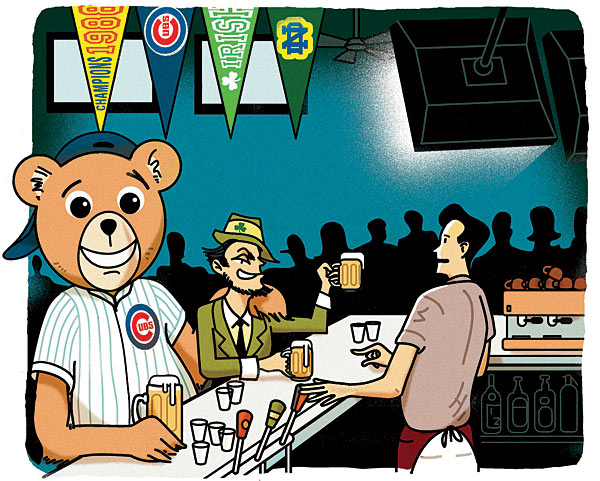
My friend Jeremy is the quintessential Notre Dame football fan. Growing up in New Jersey, he turned on the TV every fall Saturday afternoon with his dad—who also loved the Irish—to see them in action. He has spent thousands of dollars on Notre Dame memorabilia and makes a pilgrimage to South Bend every year, willingly dropping $400, if necessary, for a ticket to the game. Being there under the gaze of Touchdown Jesus, seeing the gleaming helmets, hearing the victory march, is worth it. If the team wins, that’s just gravy.
The devoted fans like Jeremy, the historic stadium, even the cute mascot: Remind you of anything else? That’s right: the Chicago Cubs. It pains me to say it, but the Fighting Irish—who celebrate their 125th anniversary this year—have become the Cubs of college football.
Let’s start with the obsession over past glories. Just as Cub fans will regale you with tales of Kerry Wood’s record 20 strikeouts in a 1998 game—despite the fact that the team hasn’t won the World Series since 1908—Irish fans can’t resist reminding you about Notre Dame’s 11 national championships, 800-plus victories (only Michigan, Yale, and Texas have more, according to the NCAA), and its slew of All-Americans and Heisman Trophy winners.
Sure, fans aren’t thrilled that Notre Dame hasn’t won a national championship since 1988. But their support continues. “Notre Dame hasn’t had an excellent team for decades, but in some ways people still remember [the glory days],” says Allen Sanderson, a sports economist at the University of Chicago.
In the same way that WGN-TV (owned by Tribune Company, Chicago’s parent) made the Cubs America’s darlings, NBC’s deal with Notre Dame has beamed the Fighting Irish into every corner of the nation since 1991. The network’s partnership with Eurosport broadcasts home games to an additional 62 countries, giving the team an international following. Even when the Irish stink, they’re in demand: Despite a dismal 3–9 season in 2007, NBC extended the school’s contract through 2015 at a reported $15 million a year—an annual pay raise of $6 million.
“That national appeal has established a brand,” says Chicago native Courtney Brunious, assistant director of the Sports Business Institute at the University of Southern California. “It has a built-in advantage that protects Notre Dame from [competition from] some regional names.”
Fan enthusiasm also manifests in ticket sales. Wrigley Field is often filled to capacity, and since 1966 every game at Notre Dame Stadium but one has been a sellout. Demand for tickets is so high that alumni must enter a lottery to obtain them—after making a donation to the university. (A private school, Notre Dame does not have to report its revenue from ticket sales. But according to Forbes, the football program realized a $47 million profit last year.)
Branded goods bring in big bucks too. From July 1, 2011, to June 30, 2012, Notre Dame ranked ninth in merchandise sales among the country’s universities, according to the Collegiate Licensing Company. And a leading online retailer of sports paraphernalia, Fanatics, reports that Irish apparel is currently its top international seller among NCAA teams.
Be it a summer day on the North Side or a fall afternoon in South Bend, the fans—and the revenue—continue to pour in. Win or lose, financial victory is assured. So when people wonder why the Fighting Irish aren’t very good anymore, the answer might be the same as for the Cubs: because they don’t need to be. Just ask my friend Jeremy.
Illustration: Christoph Hitz


